Historic Halls of Mirfield
The Old Rectory
After Hopton Hall the Old Rectory is probably the most historic domestic building in Mirfield. It stands nestled in the bend of Pinfold Lane and although it has been altered and modernised over the years it still retains much of its past character and charm.
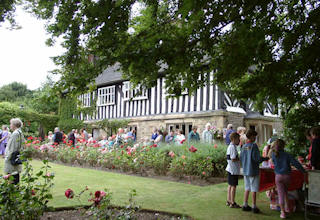
The South Face
It was built about 1300AD for the Rector of Mirfield John de Heton. The last Rector to live in the building was the Rev. John de Welyen who became Rector in 1401 and was the last Rector of Mirfield. Following his death it was the property of Kirklees Priory until 1539 and in 1540 was acquired by Thomas Savile.
During his time at the Old Rectory a former owner, Mr. Bottomley, started the practice of opening his gardens to the public once a year and I am grateful that the present owners, Angela and Gordon Lorrimer, continued this practice for the first few years after they bought the property. I was lucky enough to be present at their first open day on Sunday 22nd July 2001 which was well supported and raised a good sum of money for local charities. The photos on this page were taken at that occasion. Unfortunately in 2004 it was decided to discontinue the open day due to problems in preparing and maintaining the grounds for such an event.
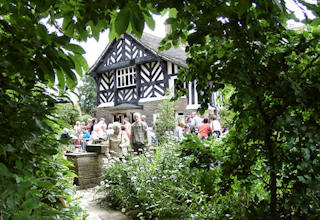
The West Gable
Angela's family are well established in the Mirfield community as her grandfather was Albert Haigh, Headmaster of Crowlees Boys' School for many, many years and was Headmaster during my time there (1947-1951). Two cottages form part of the Rectory and are situated at the rear. They formerly housed the staff but were rented out as when I was young, one of them housing the mother of Television's Crackerjack star Peter Glaze in the early 1940s.
This part of the Old Rectory has now been converted for luxury bed and breakfast accommodation and anyone interested in spending a little time in this beautiful and secluded corner of Mirfield will find full details on their website.
Blake Hall
This is Blake Hall as I remember it. It was built in 1745 but at this time owned by Mr. Maurice Avison. It was pulled down in 1954. This is the side view of the Hall. The drive leading into the picture comes from the bottom of Church Lane and it can be seen curving round to the left in front of the building where it ran out again at the bottom of Parker Lane. A further entrance came in from Pinfold Lane running past the Old Rectory to the back of the house. The garden parties were held on the extensive lawns and we had treasure hunts which allowed us into certain rooms of the house.
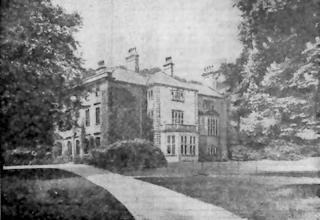
Blake Hall
At an earlier time Anne Bronte was governess for 9 months to the children of the Ingham's who then owned the Hall. Anne left the Hall at the age of 19 and her book 'Agnes Grey' is believed to be about her time at Blake Hall though she used pseudonyms for the names of the children.
One outstanding feature of Blake Hall was the Queen Anne staircase which was hand carved from rare burled yew. When the Hall was demolished in 1954 the interior was dismantled and auctioned off, with the staircase going to a London dealer. Four years later in 1958 an American couple, Allen and Gladys Topping, were in London attending the Kensington Antique Fair looking for furniture for their house which was built in 1954. One of the dealers there offered them the staircase from Blake Hall and when they saw it, it was love at first sight so the Toppings bought it and had it shipped to their house on Long Island.
There was an article in the Mirfield Reporter around 1965 reporting that Mrs. Topping, who was now widowed, saw on 3rd September 1962 a young woman ascending the stairs. The figure was dressed in a long, full skirt, her hair was held in a bun on the back of her neck and she appeared pensive. Mrs. Topping's dog became agitated and when she spoke soothingly to him the figure disappeared. It was suggested that it was the ghost of Anne Bronte but since Anne didn't die at Blake Hall I find it difficult to believe that her ghost would be walking the old staircase. However, I leave it for you to make up your own mind.
Hopton Hall
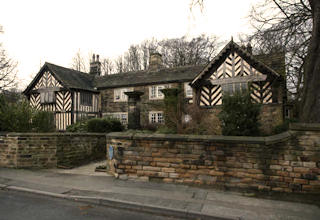
Hopton Hall
Hopton Hall has a history that reaches far back into the past. It once belonged to the Mirfield family and then the Wentworths before it was purchased by Richard Thorpe in 1560. It then remained the property of the Thorpes for almost two centuries. The Richard Thorpe who endowed Mirfield Free Grammar School was the great grandson of this Richard Thorpe and was born in 1637. The Hall was rebuilt in 1619 and has timber framed gables with herringbone strutting which can be seen in the photo. It was surrounded by a moat with a bridge that was still in position at the beginning of the 20th century. The Hall passed to the Micklethwaite family, who were maltsters, in the early 18th century.
Eastthorpe Villa
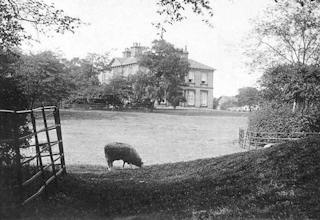
Eastthorpe Villa (Later, Springfield House)
Photo by courtesy of Philip Crowther
Eastthorpe Villa was built as the home of the Hurst family who were maltsters and carried out their business in Hurst Lane. In 1887 the house changed hands and was occupied by Frank Burnley. Following his death in 1890 the house was once again occupied by a maltster, Fred Jackson Crowther, who had the malt kilns in Station Road and who remained there until 1902.
In the 1940s it was leased by Maurice Dew and subsequently purchased by him in 1953. Around this time my wife's mother worked there as a cleaner and her father was also employed as a part time gardener. Maurice Dew also changed the name of the house to Springfield and this was the name that I always knew it by. The house was demolished in the 1960s and the site is now occupied by Springfield Park private housing estate.
Over Hall
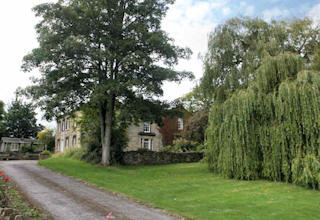
The Over Hall
Over Hall was originally called Upper Hall and was owned by the Shepley
family from 1569 and was rebuilt by Richard Shepley in 1721. It later passed by marriage to the
Stancliffe family when John Stancliffe married Esther Shepley. Between 1852 and sometime in the
1870s the Hall was used as a boarding school for ladies and an advertisement for this is reproduced
below.
The grounds have now been built on but the Hall is still there tucked away behind a
screen of trees.

MR. G. E. KENT
RECEIVES A LIMITED NUMBER OF YOUNG LADIES TO BOARD AND EDUCATE.
The religious interests and social happiness of the Pupils are objects of especial care, and every pains taken to ensure a ladylike and easy deportment.

Including Board and Instruction in the English Language, Ancient and Modern History, Geography, Composition, Writing, Arithmetic, Physical Education, etc.,
Guineas |
|
Guineas |
||
For Pupils between 16 & 20 years of age |
30 |
|
Coffee Breakfasts |
2 |
" " 10 & 16 " " |
24 |
|
Single Bed |
2 |
" " 7 & 10 " " |
20 |
|
Washing |
2 |
Use of Piano |
1 |
|
Horse Exercise |
4 |
The exercise of the Pupils is under the Superintendence of MR. G. E. KENT, who has been 16 years Professor of Physical Education in the first Scholastic Establishment in Yorkshire.


On the terms of the respective Professors.

Each Young Lady must be provided with a Silver Fork, Desert Spoon, Four Towels, One Pair of Sheets and Two Pillow Slips, which will be returned when the Pupil leaves the Establishment.
A Quarter's notice must be given in writing previous to a Pupil being removed, or a proportionate payment will be required.

QUARTER DAYS:-- JAN. 26, APRIL 5, JULY26, and SEPT. 27.
Reference to the Parents of Pupils in Russia, Sweden, Holland, Ireland, Liverpool, Manchester, Nottingham, Leeds, Huddersfield, Halifax, Bradford, &c.

OVER HALL is beautifully situated, standing within twenty-four Acres of Park Land, four of which are used as Archery, Croquet, and Play Ground, (fitted up with apparatus for exercise), Promenade, Shrubberies, &c., to which the Pupils have free access, thus conducing to their physical development and enjoyment.

A Prospectus, with a View of the Hall & Grounds, with References & Price List, forwarded on Application.
The Marmaville
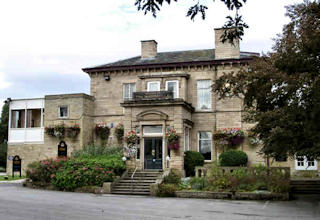
Marmaville
The Marmaville was built in 1880 for Mr. Marmaduke Fox, a woollen manufacturer and is set in spaceous grounds at the bottom of Church Lane. It was later the home of the Crowthers, maltsters of Station Road. During the Second World War it was used as a auxiliary ambulance depot. After the war it was a private club under the name of the Mushroom Club. My school friend, Tony Stewart, went to be a gardener there as his first job after leaving school.
It has been owned by several brewery companies since then and has gone under the name of the Marmaville for many years. It finally closed its doors on September 30th 2001 and is scheduled to be converted into private apartments as part of a housing complex built within its grounds. As of April 2006 the house has been demolished apart from the facade which stands alone on the site. The gatehouses have been converted but the rest of the site is still awaiting developement.
A group of friends who originated in Chorley, Lancashire, bought a derelict Victorian Mansion in Polbae, which is near Newton Stewart in Scotland and have spent almost 10 years restoring it. During their research into the history of the house they found that the former owner of the house was Major Marmaduke Sextus Fox, and his father, Marmaduke Senior of Marmavilla, Mirfield was the original purchaser of the house.
The Major and his mother are buried about 5 miles away from Polbae at Challoch Churchyard. Marmaduke, the father of the Major is also buried in the same grave even though he died whilst staying with his solicitor in Mirfield.
Paper Hall
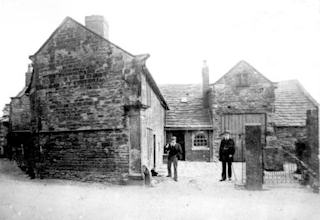
Paper Hall
Paper Hall stood at the point where Flash Lane joins to Shillbank Lane. The hall was demolished many years ago in 1911, long before my memories began, for the widening of Shillbank Lane.
It is thought that the last Prioress of Kirklees and four of her nuns lived here from 1539 after the priory closed.
In the early eighteenth century it was owned by the Dalby family but by the nineteenth century it had become the home of Samuel Asquith, a blacksmith and farmer.
Water Royd Hall
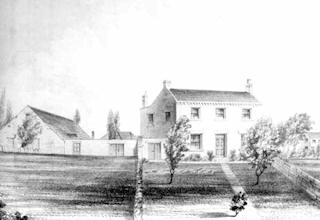
Water Royd Hall (Murder House)
Sketch by courtesy of Philip Crowther
Water Royd Hall is perhaps most famous for the murders that were perpetrated there in 1847. A monument to the victims is still to be found in the grave yard at the Baptist Chapel. The hall has now been demolished to make way for housing.
I have recently been given a leaflet relating to these murders which I am reproducing here. My thanks go to David Walker for this contribution and for the many other items he has provided that appear elsewhere on these pages.
The leaflet is in a very delicate state so the text below is a representation of the leaflet's front cover as close to the style as I could get it. The full article and verse, written in July 1847 and costing one penny, follow.
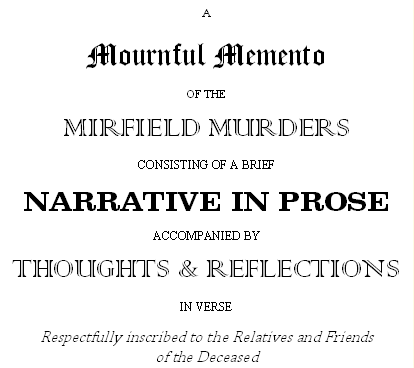
A BRIEF NARATION
OF THE
MIRFIELD MURDERS
The 12th of May, 1847, will never be forgotten by the inhabitants of Mirfield, as a day which witnessed the commission of a crime more aggravated than any recorded in the annals of modern guilt.
A family were swept away in a moment! a household perished at a stroke! perished at noon-day! and not improbably by the hands of him or them who, on previous occasions, had shared their hospitality. The family referred to consisted of Mr. James Wraith, his wife Ann, and their servant Caroline, Ellis, respectively aged 78, 65, and 21 years.
The aged pair were living upon the proceeds of their own property, in a retired, unassuming manner. The parental home of the servant Caroline is within a mile of the house in which she met her dreadful fate. The principle care of the aged gentleman appears to have been the cultivation of a few acres of land near the house; between eleven and twelve o'clock in the forenoon of the day in question, he went to the house of his nephew, which is at the distance of a few hundred yards, to engage a youthful relative to assist him in gathering stones in the after part of the day, he left the house in a few minutes and proceeded home, that was the last time he was seen alive.
His great nephew went to the house at about half-past one o'clock, being a little later than usual, in consequence of a shower of rain; he found the kitchen door quite fast, and though he listened attentively, he could hear nothing except the ticking of the clock; he then went round the house, and saw the blinds of the windows down; when he came to the front door, he discovered a pool of blood on the front step, and it was still issuing from under the door—he was immediately alarmed, ran home, and told the circumstance to his parents.
An alarm being instantly given, several of the neighbours hastened to the spot; two of them entered the house through the window of the kitchen, when a scene, dreadful beyond description, presented itself,— on the floor was laid Caroline Ellis, quite dead, her head shivered, her brains dashed out, her throat cut, and surrounded by a pool of her own blood,—in the passage leading to the parlour, was found Mrs. Wraith also quite dead, and in a most dreadfully mutilated state, her head fearfully beaten, her features presenting a most horrid spectacle, and her throat also cut,—in the parlour, on the right hand going towards the front door, (in which the family appear to have dined,) Mr. Wraith himself was found, mutilated and disfigured in the same horrid manner, his head being literally crushed, and his throat cut almost from ear to ear.
The aggravation of this awful massacre was threefold,—a family perished at one fatal stroke,—they were slaughtered in the most barbarous manner, and that too surrounded by the full blaze of the noon-day sun. Little did the unsuspecting victims think, as they sat down around the domestic board, that they were passing their last hour upon earth,—little did the old man think, as he sat ruminating on the engagements of the day, that his earthly work was done, and he must see the smiling countenance of his youthful relative no more. Little did his aged partner think, while exercising the kindliest feelings of our nature in feeding the objects of her care, that the fell destroyer was about to spring upon her like a blood-thirsty tiger, strike her to the earth, and imbrue his guilty hands in her blood. Little did that lovely female dream, while preparing for the festivities of the coming season,1 that the hopes of earth so soon must fade, and the flowers of love so soon be blighted; and little did she think, that instead of a bridal robe, she so soon must wear a funeral shroud,—but so it was! According to all probability, the helpless sufferers were cut off, and sent to their final account without a moment's warning.
Comment is superfluous, as the tale is on every tongue, so the comment is graven on every heart; it speaks to every soul not dead to feeling, in language stronger than the poet or the historian can employ; but while terror, sorrow, and sympathy combined, fill the breast with one overwhelming emotion, let us remember in the midst of all, that the judge of all the earth will most assuredly do right.
It may be stated in conclusion, that two individuals are in custody, charged with the perpetration of the horrible deed; to say any thing here on the strength or weakness of the evidence adduced against them is unnecessary, and would be highly improper; the facts of the case have been again and again presented before the public eye, and though the prisoners are remanded for a season, there is not the slightest doubt that, if they are the guilty parties, justice will ultimately overtake them.
The following reflections on the tragic affair are commended to the candour and indulgence of an enlightened public; the author's design has not been to excite popular fury against the assassins, but rather to perpetuate an abhorrence of their appalling crime, by embodying the popular sympathy in an enduring form.
1 It being the day before Mirfield Feast.
Footnote: An Irish tinker, Patrick Reid, was hanged for the crime at York in 1848 and his accomplice, Michael McAbe, was transported.
THOUGHTS, REFLECTIONS, &c.
But deeds of blood, in thrilling tones, demand an effort now;
With bleeding heart, and tearful eyes, I write with trembling hand,
To stamp upon a fiend-like crime an everlasting brand.
That flings a dark and sombrous cloud o'er Calder's smiling vale:
The blood of those now hush'd in death sends forth a piercing cry,
That deeply wounds each feeling heart beneath the British sky.
Her children are but seldom found among the guilty band;
Hence sadly did we shudder when this demon act was known,
But thought the arm that struck the blow was not one of our own.
Not in the shade of mid-night gloom, but 'neath the noon-day sun,—
Not in the silent hour of sleep, when mortals cease from strife,
But midst the cheerful din of day—the teeming tide of life.
Their wanderings might be nearly o'er in this dark vale of tears;
But life 'tis said, is very sweet, tho' wrinkles mar the brow,
And tho' we have but once to die—we always say, not now!
Which one might almost think would hush the rudest ruffian's rage;
But when revenge hath fill'd the heart, the demon will not spare,
The smiling maid of tender years, nor sire of hoary hair.
While the bright future shone with love, she sank into the tomb;
She thought of all the bliss of life, a stranger to its sorrow,
But her sun went down in darkness, while she thought about the morrow.
To wipe away the trembling tear, and catch thy latest prayer;
If death's dark waters chill the heart when friends are standing by,
Methinks it must be fearful when no sympathy is nigh.
Methought I heard thee sweetly say, ‘you cannot harm me now;’)
O had thy Murd'rer seen thee, like a lovely child at rest,
What barbed arrows must have pierced the villain's guilty breast.
No interval of time allowed to sob a sad farewell;
One moment saw them all at peace, and danger seem'd afar—
Another pass'd—and lo! they stood before the Judgment Bar!
But yet we saw enough to make the stoutest spirit quail;
We saw a scene more dreadful than we ever saw before—
We saw a Murderer had been there and dy'd his hands with gore.
Since he had lent a golden beam to guide a demon's blow;
And when we heard the mournful sound of evening's gentle breath,
It seem'd to whisper fearful things of some unsightly death.
Whose barb'rous hand had shed the blood, whose conscience bore the guilt;
We all have seen we lightning's flash, and heard the thunders roll,
A wilder storm by far than that would toss his guilty soul.
Nor be it mine to glory in a fallen brother's shame,
(I call the murderer brother, but my reader do not start,
The principles that nerv'd his arm, are found in every heart.
Art thou prepar'd to stand before the great tribunal now?
The assassin may not end thy life, yet thou may'st fall as soon,
Beneath disease as gleaming steel, at Midnight or at Noon.
Then what tho' earth and hell assail, tho' strife and death surround,
Thou shalt lift up thy head with joy, and see thy smiling home,
Where pains & perils are not known, where murd'rers cannot come.